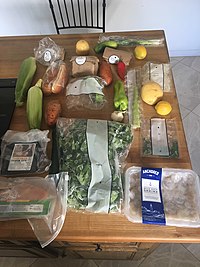
Photo from wikipedia
INTRODUCTION Laboratory studies have shown that exercise can reduce energy intake, with a benefit to moderate-to-vigorous physical activity (MVPA) in individuals. The aim of the current study was to identify… Click to show full abstract
INTRODUCTION Laboratory studies have shown that exercise can reduce energy intake, with a benefit to moderate-to-vigorous physical activity (MVPA) in individuals. The aim of the current study was to identify the impact of MVPA before lunch on ad libitum energy intake in very young children in a natural setting. METHODS Three conditions were tested on three occasions, each using a counterbalance testing sequence as follows: A) Meal_MVPA: Meal at the beginning of the lunch period followed by a 40-min MVPA (reference condition); B) LPA_meal: 40 min of light intensity exercise session followed by lunch; C) MVPA_meal: MVPA followed by lunch. Children were instructed to eat their ad libitum lunch box (7-9 items) to reach 4/5 on the satiety visual analogue scale. RESULTS 21 participants [8 boys and 13 girls; 80% normal weight; mean age: 5.6 (standard deviation: 0.5) years] participated in the study. Energy intake was significantly greater in the LPA_Meal condition [509 kcal (95% confidence interval: 448-570)] than in Meal_MVPA [442 kcal (380-504)] (p = 0.011) and MVPA_Meal [432 kcal (371-494)] (p < 0.001) conditions (p < 0.05). The energy from lipids was significantly greater in the LPA_Meal [154 kcal (130-177)] than in Meal_MVPA conditions [120 kcal (97-144)] (p = 0.016). CONCLUSION The current study may indicate that it is possible for young school children to benefit from anorexigenic exercise in real-life settings. In addition, it was possible to delay mealtime without increasing energy intake when MVPA was provided during the delay period. Finally, the introduction of MVPA prevented an increase in lipid consumption observed for LPA.
Journal Title: Appetite
Year Published: 2018
Link to full text (if available)
Share on Social Media: Sign Up to like & get
recommendations!